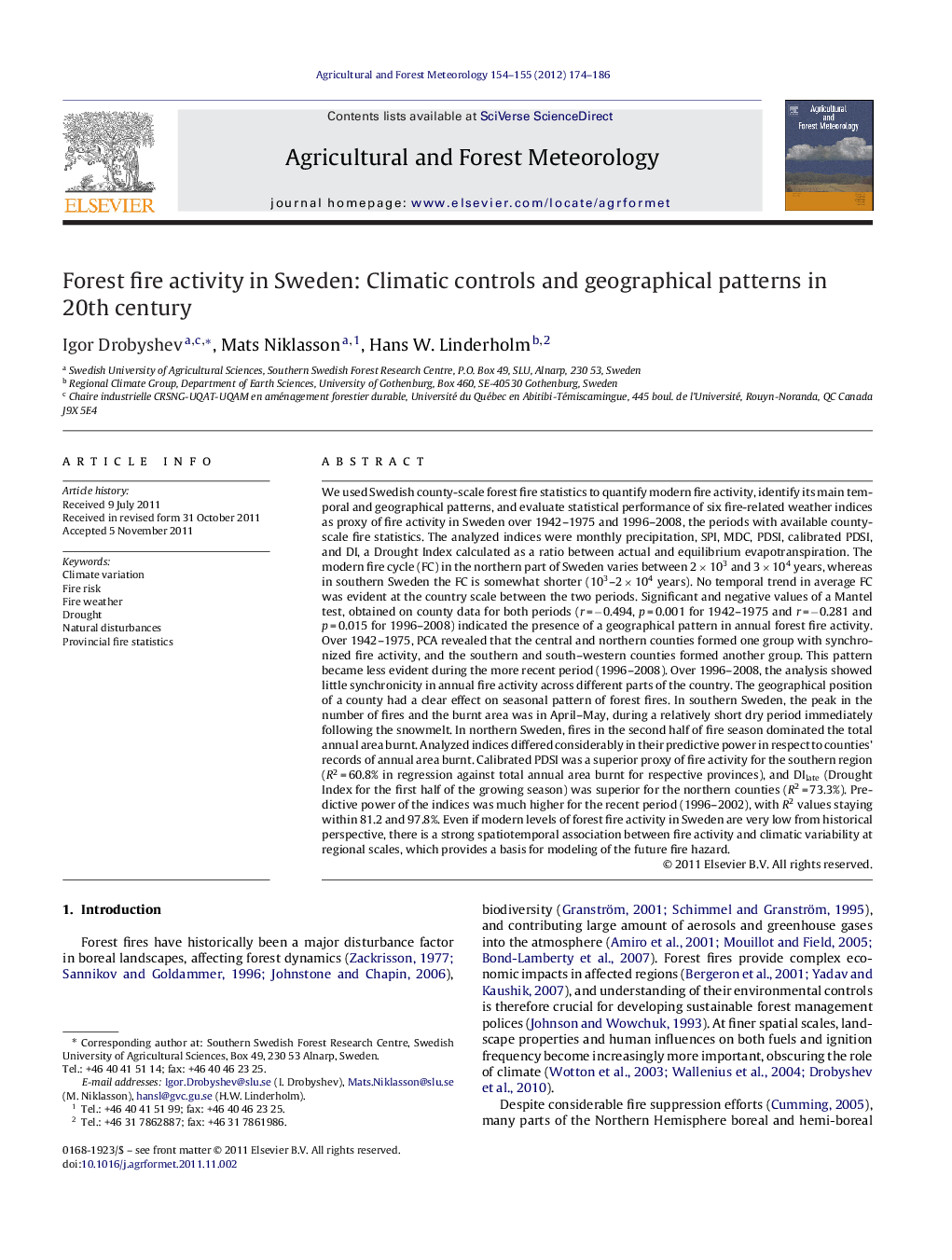| کد مقاله | کد نشریه | سال انتشار | مقاله انگلیسی | نسخه تمام متن |
|---|---|---|---|---|
| 82097 | 158372 | 2012 | 13 صفحه PDF | دانلود رایگان |

We used Swedish county-scale forest fire statistics to quantify modern fire activity, identify its main temporal and geographical patterns, and evaluate statistical performance of six fire-related weather indices as proxy of fire activity in Sweden over 1942–1975 and 1996–2008, the periods with available county-scale fire statistics. The analyzed indices were monthly precipitation, SPI, MDC, PDSI, calibrated PDSI, and DI, a Drought Index calculated as a ratio between actual and equilibrium evapotranspiration. The modern fire cycle (FC) in the northern part of Sweden varies between 2 × 103 and 3 × 104 years, whereas in southern Sweden the FC is somewhat shorter (103–2 × 104 years). No temporal trend in average FC was evident at the country scale between the two periods. Significant and negative values of a Mantel test, obtained on county data for both periods (r = −0.494, p = 0.001 for 1942–1975 and r = −0.281 and p = 0.015 for 1996–2008) indicated the presence of a geographical pattern in annual forest fire activity. Over 1942–1975, PCA revealed that the central and northern counties formed one group with synchronized fire activity, and the southern and south–western counties formed another group. This pattern became less evident during the more recent period (1996–2008). Over 1996–2008, the analysis showed little synchronicity in annual fire activity across different parts of the country. The geographical position of a county had a clear effect on seasonal pattern of forest fires. In southern Sweden, the peak in the number of fires and the burnt area was in April–May, during a relatively short dry period immediately following the snowmelt. In northern Sweden, fires in the second half of fire season dominated the total annual area burnt. Analyzed indices differed considerably in their predictive power in respect to counties’ records of annual area burnt. Calibrated PDSI was a superior proxy of fire activity for the southern region (R2 = 60.8% in regression against total annual area burnt for respective provinces), and DIlate (Drought Index for the first half of the growing season) was superior for the northern counties (R2 = 73.3%). Predictive power of the indices was much higher for the recent period (1996–2002), with R2 values staying within 81.2 and 97.8%. Even if modern levels of forest fire activity in Sweden are very low from historical perspective, there is a strong spatiotemporal association between fire activity and climatic variability at regional scales, which provides a basis for modeling of the future fire hazard.
► We used county-scale forest fire statistics to identify the main patterns of forest fires in Sweden.
► The modern fire cycle in Sweden varies between 103 and 104 years.
► Our study revealed the presence of a strong geographical pattern in annual forest fire activity.
► The geographical position of a county had a clear effect on seasonal pattern of forest fires.
► Analyzed climate indexes differed in their predictive power in respect to annual area burned.
Journal: Agricultural and Forest Meteorology - Volumes 154–155, 15 March 2012, Pages 174–186